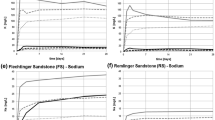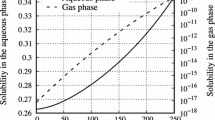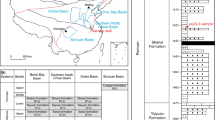Abstract
To meet the extensive demand for lithium (Li) for rechargeable batteries, it is crucial to enhance Li production by diversifying its resources. Recent studies have found that produced water from shale reservoirs contains various organic and inorganic components, including a significant amount of Li. In this study, findings from hydrothermal reaction experiments were analyzed to fully understand the release of Li from organic-rich shale rock. Subsequently, numerical algorithms were developed for both pore-scale and continuum-scale models to simulate the long-term behavior of Li in shale brines. The experimental conditions considered four different hydrothermal solutions, including the solutions of KCl, MgCl2, CaCl2, and NaCl with various concentrations under the temperature of 130 °C, 165 °C, and 200 °C. The release of Li from shale rock into fluid was regarded as a chemical interaction of cation exchange between rock and fluid. The reactive transport pore-scale and upscaled continuum-scale models were developed by coupling the chemical reaction model of Li interaction between rock and fluid. The model was first implemented to investigate the release and transport of Li in the pore scale. Continuum-scale properties, such as effective diffusivity coefficients and Li release rate, were obtained as the field-averaged pore-scale modeling results. These properties were used as the input data for the upscaled continuum-scale simulation. The findings of this study are expected to provide new insight into the production of Li from shale brines by elucidating the release, fate, and transport of Li in subsurface formations.








Similar content being viewed by others
Abbreviations
- \({D}_{{\text{eff}}}\) :
-
Effective diffusion coefficient
- \({D}_{i}\) :
-
Molecular diffusivity of component i in fluid
- \(k\) :
-
Local permeability
- \({k}_{0}\) :
-
Initial local permeability
- \({R}_{i}\) :
-
Reaction rate of component i in fluid
- \(S\) :
-
Specific surface area
- \({\varepsilon }_{{\text{f}}}\) :
-
Volume fraction of fluid area
- \({\varepsilon }_{{\text{s}}}\) :
-
Volume fraction of rock
- \({\overline{v} }_{{\text{f}}}\) :
-
Average velocity of fluid
- \({\overline{p} }_{{\text{f}}}\) :
-
Average pressure
- \({\mu }_{{\text{f}}}\) :
-
Dynamic viscosity
- \({\rho }_{{\text{f}}}\) :
-
Fluid density
- \({\rho }_{{\text{s}}}\) :
-
Rock density
- \({\overline{\omega }}_{{\text{f}},i}\) :
-
Concentration of component i in fluid
- \(\psi \) :
-
Diffuse-interface function
- f:
-
Fluid phase
- s:
-
Solid phase
References
Blender Foundation, community. Blender. https://www.blender.org/.
Chan, L.-H., Starinsky, A., Katz, A.: The behavior of lithium and its isotopes in oilfield brines: evidence from the Heletz–Kokhav field, Israel. Geochim. Cosmochim. Acta 66(4), 615–623 (2002)
Chapman, H.D.: Cation-exchange capacity. In: Norman, A.G. (ed.) Methods of Soil Analysis: Part 2 Chemical and Microbiological Properties, pp. 891–901. American Society of Agronomy, Soil Science Society of America, Madison (1965)
Deng, H., Tournassat, C., Molins, S., et al.: A pore-scale investigation of mineral precipitation driven diffusivity change at the column-scale. Water Resources Res. 57(5), e2020WR028483 (2021). https://doi.org/10.1029/2020WR028483
Eberl, D.D.: Alkali cation selectivity and fixation by clay minerals. Clays Clay Miner. 28, 161–172 (1980a)
El Oualid, S., Lachat, R., Candusso, D., et al.: Characterization process to measure the electrical contact resistance of gas diffusion layers under mechanical static compressive loads. Int. J. Hydrog. Energy 42(37), 23920–23931 (2017)
Flexer, V., Baspineiro, C.F., Galli, C.I.: Lithium recovery from brines: a vital raw material for green energies with a potential environmental impact in its mining and processing. Sci. Total. Environ. 639, 1188–1204 (2018)
Jang, E., Jang, Y., Chung, E.: Lithium recovery from shale gas produced water using solvent extraction. Appl. Geochem. 78, 343–350 (2017)
Kimura, S., Takagi, Y., Tone, S., et al.: A rate equation for gas-solid reactions accounting for the effect of solid structure and its application. J. Chem. Eng. Jpn. 14(6), 456–461 (1981)
Leal, L.G.: Laminar Flow and Convective Transport Processes, vol. 251. Elsevier (1992)
Lee, K.J.: Potential of petroleum source rock brines as a new source of lithium : insights from basin-scale modeling and local sensitivity analysis. Energy Rep. 8, 56–68 (2022)
Lee, K.J., You, J., Gao, Y., et al.: Release, transport, and accumulation of lithium in shale brines. Fuel 356, 129629 (2024)
Phan, T.T., Capo, R.C., Stewart, B.W., et al.: Factors controlling Li concentration and isotopic composition in formation waters and host rocks of Marcellus Shale, Appalachian Basin. Chem. Geol. 420, 162–179 (2016)
Sawhney, B.L.: Selective sorption and fixation of cations by clay minerals: a review. Clays Clay Miner. 20, 93–100 (1972a)
Teichert, Z., Bose, M., Williams, L.B.: Lithium isotope compositions of U.S. coals and source rocks: potential tracer of hydrocarbons. Chem. Geol. 549, 119694 (2020)
USGS. 2020. Lithium Data Sheet—Mineral Commodity Summaries 2020. https://pubs.usgs.gov/periodicals/mcs2020/mcs2020-lithium.pdf.
Vine, J.D.: Lithium in sediments and brines—how, why, and where to search. J. Res. u. s. Geol. Surv. 3(4), 479–485 (1975)
Weller, H.G., Tabor, G., Jasak, H., et al.: A tensorial approach to computational continuum mechanics using object-oriented techniques. Comput. Phys. 12(6), 620–631 (1998)
Williams, L.B., Crawford Elliott, W., Hervig, R.L.: Tracing hydrocarbons in gas shale using lithium and boron isotopes: Denver Basin USA, Wattenberg gas field. Chem. Geol. 417, 404–413 (2015)
You, J., Lee, K.J.: A pore-scale investigation of surface roughness on the evolution of natural fractures during acid dissolution using DBS method. J. Pet. Sci. Eng. 108728 (2021b). https://www.sciencedirect.com/science/article/pii/S0920410521003880
You, J., Lee, K.J.: Pore-scale study to analyze the impacts of porous media heterogeneity on mineral dissolution and acid transport using Darcy–Brinkmann–Stokes method. Transp. Porous Med. 137(3), 575–602 (2021a)
You, J., Lee, K.J.: The experimental investigation and data–driven modeling for thermal decomposition kinetics of Green River Shale. Fuel 320, 123899 (2022)
Yu, J.Q., Gao, C.L., Cheng, A.Y., et al.: Geomorphic, hydroclimatic and hydrothermal controls on the formation of lithium brine deposits in the Qaidam Basin, northern Tibetan Plateau, China. Ore Geol. Rev. 50, 171–183 (2013)
Funding
The authors appreciate the funding for this research from National Science Foundation under Award 2042504 (CAREER: Identifying a New Source of Lithium for Sustainable and Renewable Energy Storage).
Author information
Authors and Affiliations
Corresponding author
Ethics declarations
Conflict of interest
The authors declare no conflict of interests.
Additional information
Publisher's Note
Springer Nature remains neutral with regard to jurisdictional claims in published maps and institutional affiliations.
Supplementary Information
Below is the link to the electronic supplementary material.
Rights and permissions
Springer Nature or its licensor (e.g. a society or other partner) holds exclusive rights to this article under a publishing agreement with the author(s) or other rightsholder(s); author self-archiving of the accepted manuscript version of this article is solely governed by the terms of such publishing agreement and applicable law.
About this article
Cite this article
You, J., Lee, K.J. Pore-Scale and Upscaled Investigations of Release and Transport of Lithium in Organic-Rich Shales. Transp Porous Med 151, 813–830 (2024). https://doi.org/10.1007/s11242-024-02071-2
Received:
Accepted:
Published:
Issue Date:
DOI: https://doi.org/10.1007/s11242-024-02071-2




